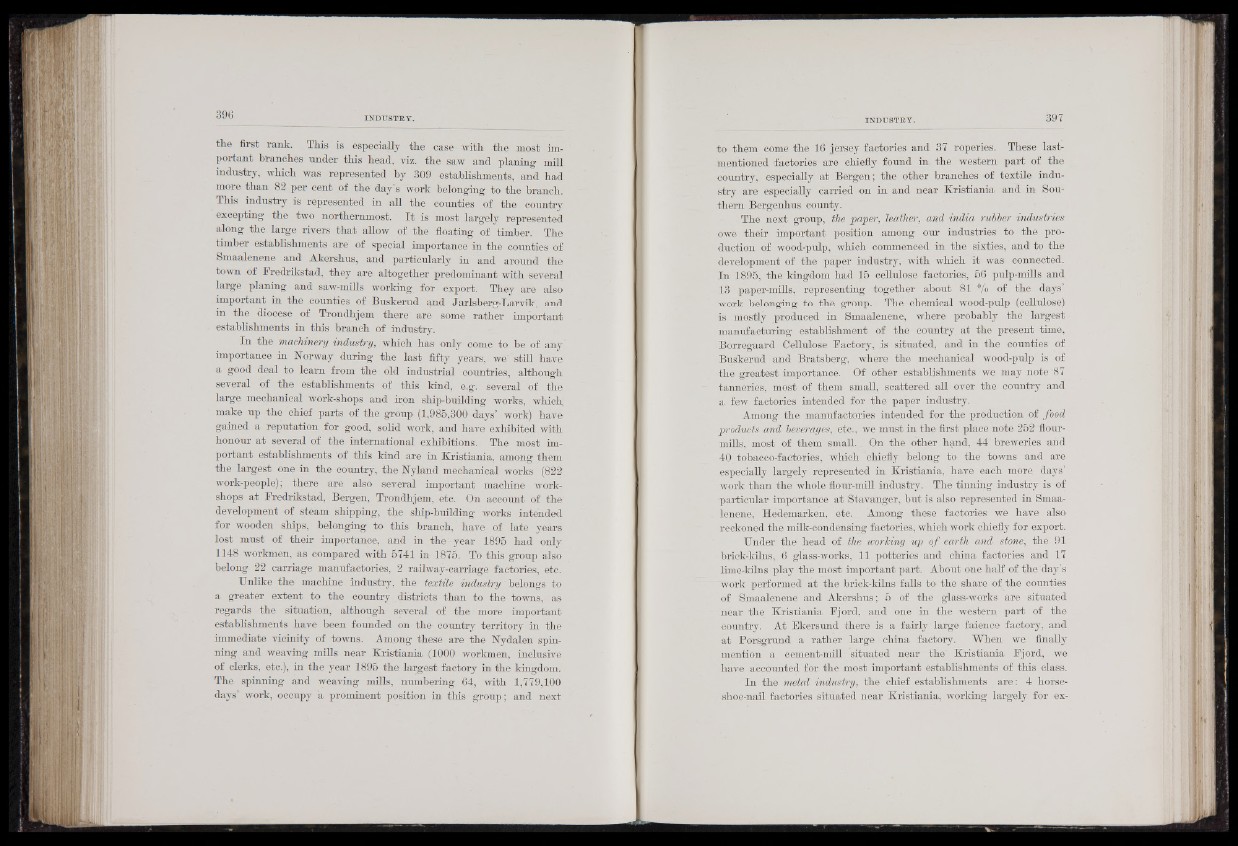
the first rant. This is especially the ease with the most important
branches under this head, viz. the saw and planing mill
industry, which was represented by 309 establishments, and had
more than 82 per cent of the day’s work belonging to the branch.
This industry is represented in all the counties of the country
excepting the two northernmost. I t is most largely represented
along the large rivers that allow of the floating of timber. The
timber establishments are of special importance in the counties of
Smaalenene and Akershus, and particularly in and around the
town of Fredrikstad, they are altogether predominant with several
large planing and saw-mills working for export. They are also
important in the counties of Buskerud and Jarlsberg-Larvik, and
in the diocese of Trondhjenl there are some rather important
establishments in this branch of industry.
In the machinery industry, which has only come to be of any'
importance in Norway during the last fifty years, we still have
a good deal to learn from the old industrial countries, although
several of the establishments of this kind, e.g. several of the
large mechanical work-shops and iron ship-building works, which,
make up the chief parts of the group (1,985,300 days’ work) have
gained a reputation for good, solid work, and have exhibited with
honour at several of the international exhibitions. The most important
establishments 'of this kind are in Kristiania, among them
the largest one in the country, the Nyland mechanical works (822
work-people); there are also several important machine workshops
at Fredrikstad, Bergen, Trondhjem, etc. On account of the
development of steam shipping, the ship-building works intended
for wooden ships, belonging to this branch, have of late years
lost must of their importance, and in the-year 1895 had only
1148 workmen, as compared with 5741 in 1875. To this group also
belong 22 carriage manufactories, 2 railway-carriage factories, etc.
Unlike the machine industry, the textile industry belongs to
a greater extent to the country districts than to the towns, as
regards the situation, although several of the more important
establishments have been founded on the- country territory in the
immediate vicinity of towns. Among these are the Nydalen spinning
and weaving mills near Kristiania (1000 workmen, inclusive
of clerks, etc.), in the year 1895 the largest factory in the kingdom.
The spinning and weaving mills, numbering 64, with 1,779,100
days’ work, occupy a prominent position in this group; and next
to them come the 16 jersey factories and 37 roperies. These last-
mentioned factories are chiefly found in. the western part of the
country, especially at Bergen; the other branches of textile industry
are especially carried on in and near Kristiania and in Southern
Bergenhus county.
The next group, the paper, leather, and india rubber industries
owe their important position among our industries to the production
of wood-pulp, which commenced in the sixties, and to the
development of the paper industry, with which it was connected.
In 1895; the kingdom had 15 cellulose factories, 56 pulp-mills and
13 paper-mills, representing together about 81 % of the days’
work belonging to the group. The chemical wood-pulp (cellulose)
is mostly produced in Smaalenene, where probably the largest
manufacturing establishment of the country at the present time,
Borregaard Cellulose Factory, .is situated, and in the counties of
Buskerud and Bratsberg, where the mechanical wood-pulp is of
the greatest importance:.. Of other establishments we may note 87
tanneries, most of them small, scattered all over the country and
a few factories intended for the paper industry.
Among the manufactories intended for the production of food
products and beveragesetc., we must in the first place note 252 flourmills,
most of them small. On the other hand, 44 breweries and
40 tobaceo-factories, which chiefly belong to the towns and are
especially largely represented in Kristiania, have each more, days’
work than the whole flour-mill industry. The tinning industry is of
particular importance at Stavanger, but is also represented in Smaalenene,
Hedemarken, etc. Among these factories we have also
reckoned the milk-condensing factories, which work chiefly for export.
Under the head of the working up of earth and stone, the 91
brick-kilns, 6 glass-works, 11 potteries and china factories and 17
lime-kilns play the most important part. About one half of the day’s
work performed at the brick-kilns falls to the share of the counties
of Smaalenene and Akershus; 5 of the glass-works are situated
near the Kristiania Fjord, and one in the western part of the
country. At Ekersund there is a fairly large faience factory, and
at Porsgrund a rather large china factory. When we finally
mention a cement-mill "situated near the' Kristiania Fjord, we
have accounted for the most important establishments of this class.
In the metal industry, the chief establishments are: 4 horse-
shoe-nail factories situated near Kristiania, working largely for ex